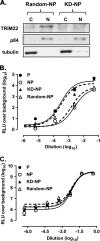TRIM22 inhibits HIV-1 transcription independently of its E3 ubiquitin ligase activity, Tat, and NF-kappaB-responsive long terminal repeat elements
- PMID: 21345949
- PMCID: PMC3126207
- DOI: 10.1128/JVI.02302-10
TRIM22 inhibits HIV-1 transcription independently of its E3 ubiquitin ligase activity, Tat, and NF-kappaB-responsive long terminal repeat elements
Erratum in
-
Correction for Kajaste-Rudnitski et al., "TRIM22 Inhibits HIV-1 Transcription Independently of Its E3 Ubiquitin Ligase Activity, Tat, and NF-κB-Responsive Long Terminal Repeat Elements".J Virol. 2025 Feb 25;99(2):e0207124. doi: 10.1128/jvi.02071-24. Epub 2025 Jan 27. J Virol. 2025. PMID: 39868830 Free PMC article. No abstract available.
Abstract
Previous studies identified clones of the U937 promonocytic cell line that were either permissive or nonpermissive for human immunodeficiency virus type 1 (HIV-1) replication. These clones were investigated further in the search for host restriction factors that could explain their differential capacity to support HIV-1 replication. Among known HIV-1 restriction factors screened, tripartite motif-containing protein 22 (TRIM22) was the only factor constitutively expressed in nonpermissive and absent in permissive U937 cells. Stable TRIM22 knockdown (KD) rescued HIV-1 long-terminal-repeat (LTR)-driven transcription in KD-nonpermissive cells to the levels observed in permissive cells. Conversely, transduction-mediated expression of TRIM22 in permissive cells reduced LTR-driven luciferase expression by ∼7-fold, supporting a negative role of TRIM22 in HIV-1 transcription. This finding was further confirmed in the human T cell line A3.01 expressing TRIM22. Moreover, overexpression of TRIM22 in 293T cells significantly impaired basal and phorbol myristate acetate-ionomycin-induced HIV-1 LTR-driven gene expression, whereas inhibition of tumor necrosis factor alpha-induced viral transcription was a consequence of lower basal expression. In agreement, TRIM22 equally inhibited an LTR construct lacking the tandem NF-κB binding sites. In addition, TRIM22 did not affect Tat-mediated LTR transactivation. Finally, these effects were independent of TRIM22 E3 ubiquitin-ligase activity. In the context of replication-competent virus, significantly higher levels of HIV-1 production were observed in KD-nonpermissive versus control nonpermissive U937 cells after infection. In contrast, lower peak levels of HIV-1 replication characterized U937 and A3.01 cells expressing TRIM22 versus their control transduced counterpart. Thus, nuclear TRIM22 significantly impairs HIV-1 replication, likely by interfering with Tat- and NF-κB-independent LTR-driven transcription.
Figures













Similar articles
-
HIV-1 transcriptional silencing caused by TRIM22 inhibition of Sp1 binding to the viral promoter.Retrovirology. 2015 Dec 18;12:104. doi: 10.1186/s12977-015-0230-0. Retrovirology. 2015. PMID: 26683615 Free PMC article.
-
The MHC-II transactivator CIITA inhibits Tat function and HIV-1 replication in human myeloid cells.J Transl Med. 2016 Apr 18;14:94. doi: 10.1186/s12967-016-0853-5. J Transl Med. 2016. PMID: 27089879 Free PMC article.
-
Inhibition of human immunodeficiency virus type 1 replication by a Tat-activated, transduced interferon gene: targeted expression to human immunodeficiency virus type 1-infected cells.J Virol. 1995 Jan;69(1):110-21. doi: 10.1128/JVI.69.1.110-121.1995. J Virol. 1995. PMID: 7983701 Free PMC article.
-
The interferon-stimulated gene TRIM22: A double-edged sword in HIV-1 infection.Cytokine Growth Factor Rev. 2018 Apr;40:40-47. doi: 10.1016/j.cytogfr.2018.02.001. Epub 2018 Feb 10. Cytokine Growth Factor Rev. 2018. PMID: 29650252 Review.
-
TRIM22. A Multitasking Antiviral Factor.Cells. 2021 Jul 23;10(8):1864. doi: 10.3390/cells10081864. Cells. 2021. PMID: 34440633 Free PMC article. Review.
Cited by
-
Reversible Human Immunodeficiency Virus Type-1 Latency in Primary Human Monocyte-Derived Macrophages Induced by Sustained M1 Polarization.Sci Rep. 2018 Sep 24;8(1):14249. doi: 10.1038/s41598-018-32451-w. Sci Rep. 2018. PMID: 30250078 Free PMC article.
-
TRIM14 inhibits hepatitis C virus infection by SPRY domain-dependent targeted degradation of the viral NS5A protein.Sci Rep. 2016 Aug 31;6:32336. doi: 10.1038/srep32336. Sci Rep. 2016. PMID: 27578425 Free PMC article.
-
Type I Interferon at the Interface of Antiviral Immunity and Immune Regulation: The Curious Case of HIV-1.Scientifica (Cairo). 2013;2013:580968. doi: 10.1155/2013/580968. Epub 2013 Dec 22. Scientifica (Cairo). 2013. PMID: 24455433 Free PMC article. Review.
-
Mechanisms of HIV-1 Control.Curr HIV/AIDS Rep. 2017 Jun;14(3):101-109. doi: 10.1007/s11904-017-0357-9. Curr HIV/AIDS Rep. 2017. PMID: 28466391 Free PMC article. Review.
-
TRIM protein-mediated regulation of inflammatory and innate immune signaling and its association with antiretroviral activity.J Virol. 2013 Jan;87(1):257-72. doi: 10.1128/JVI.01804-12. Epub 2012 Oct 17. J Virol. 2013. PMID: 23077300 Free PMC article.
References
-
- Alfano M., Rizzi C., Poli G., Biswas P. 2007. HIV-1 Infection of promonocytic U937 and U1 cell lines: clonal distribution of innate restriction factors, p. 89–114 In Herbein G. (ed.), Macrophage and HIV infection. Transworld Research Network, Kerala, India
-
- Asjo B., et al. 1987. Susceptibility to infection by the human immunodeficiency virus (HIV) correlates with T4 expression in a parental monocytoid cell line and its subclones. Virology 157:359–365 - PubMed
-
- Ben-Neriah Y. 2002. Regulatory functions of ubiquitination in the immune system. Nat. Immunol. 3:20–26 - PubMed
Publication types
MeSH terms
Substances
Grants and funding
LinkOut - more resources
Full Text Sources
Other Literature Sources

